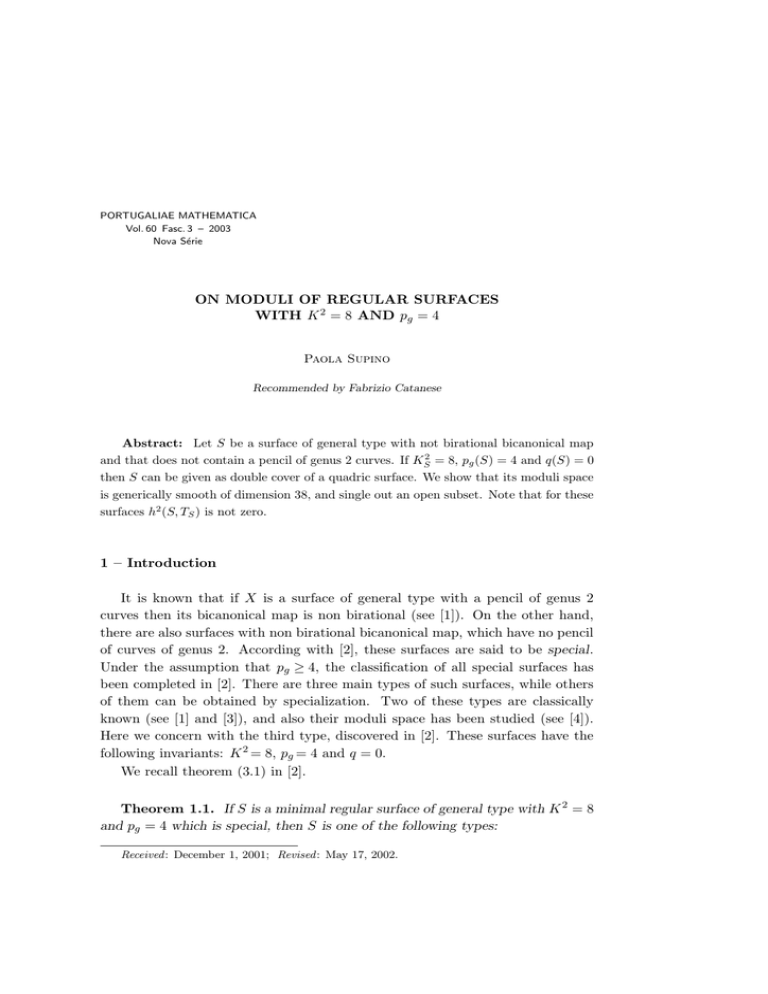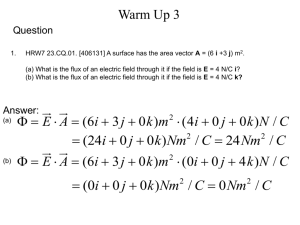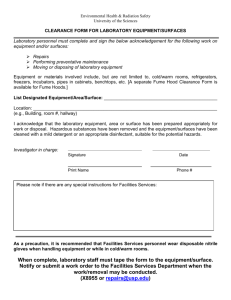ON MODULI OF REGULAR SURFACES WITH K = 8 AND p = 4
advertisement

PORTUGALIAE MATHEMATICA Vol. 60 Fasc. 3 – 2003 Nova Série ON MODULI OF REGULAR SURFACES WITH K 2 = 8 AND pg = 4 Paola Supino Recommended by Fabrizio Catanese Abstract: Let S be a surface of general type with not birational bicanonical map and that does not contain a pencil of genus 2 curves. If KS2 = 8, pg (S) = 4 and q(S) = 0 then S can be given as double cover of a quadric surface. We show that its moduli space is generically smooth of dimension 38, and single out an open subset. Note that for these surfaces h2 (S, TS ) is not zero. 1 – Introduction It is known that if X is a surface of general type with a pencil of genus 2 curves then its bicanonical map is non birational (see [1]). On the other hand, there are also surfaces with non birational bicanonical map, which have no pencil of curves of genus 2. According with [2], these surfaces are said to be special. Under the assumption that pg ≥ 4, the classification of all special surfaces has been completed in [2]. There are three main types of such surfaces, while others of them can be obtained by specialization. Two of these types are classically known (see [1] and [3]), and also their moduli space has been studied (see [4]). Here we concern with the third type, discovered in [2]. These surfaces have the following invariants: K 2 = 8, pg = 4 and q = 0. We recall theorem (3.1) in [2]. Theorem 1.1. If S is a minimal regular surface of general type with K 2 = 8 and pg = 4 which is special, then S is one of the following types: Received : December 1, 2001; Revised : May 17, 2002. 354 PAOLA SUPINO (i) The canonical system K has four distinct simple base points p1 , p2 , q1 , q2 . The canonical map φKS is of degree 2 onto a smooth quadric Q of P3 . If p : Se → S is the blow-up of the points p1 , p2 , q1 , q2 , then there exists a morphism ϕ : Se → Q ⊂ P3 such that ϕ = φKS ◦ p. The morphism ϕ is generically finite of degree 2, with branch curve B on Q of type B = η1 + η2 + η10 + η20 + B 0 , where η1 , η10 are two distinct lines of the same ruling of Q, η2 , η20 are two distinct lines of the other ruling, B 0 is a curve of type (8, 8) not containing ηi , ηi0 , having 4-uple points at the intersection of the four lines, and no further essential singularity. (ii) The canonical system |KS | has a fixed component which is an irreducible (-2)-curve Z. The linear system |KS − Z| has no fixed component but has two distinct simple base points. The canonical map φKS has degree 2 onto a smooth quadric Q of P3 . If p : Se → S is the blow-up of the base points of |KS − Z|, then there exists a morphism ϕ : Se → Q such that ϕ = φKS ◦p. The morphism ϕ is generically finite of degree 2, with branch curve B on Q of type B = η + η 0 + B 0 , where η, η 0 are two distinct lines of the same ruling of Q, B 0 is a curve of type (8, 8) not containing η, η 0 , having two [4, 4]-points at the intersection of the η, η 0 with a line of the other ruling, and tangent lines η, η 0 , and no further essential singularity. Remark 1.2. Here, the essential singularities are the ones that affect the invariants of S. The surfaces in theorem 1.1(ii) are specialization of the surfaces in theorem 1.1(i). We call general the latter surfaces and particular the former ones (see remark (3.10) in [2]). For the tangent bundle one has (1) χ(TS ) = −10 χ(OS ) + 2 KS2 = −34 . We will prove the following: Theorem 1.3. The family F of regular surfaces with K 2 = 8, pg = 4 with non trivial torsion and without a pencil of genus 2 curves described in theorem 1.1(i) corresponds to an open subset of its moduli space, which is irreducible, smooth of dimension 38. The prove is based on the geometric description of S by means of the double map on the quadric surface Q. ON MODULI OF REGULAR SURFACES WITH K 2 = 8 AND pg = 4 355 1.1. Notations and set up We recall the notations used in [2]: we consider n = η1 ∩ η2 , n0 = η10 ∩ η20 , m = η2 ∩ η10 , m0 = η1 ∩ η20 , points on the quadric Q. We denote by Ei , Ei0 for i = 1, 2 the exceptional curves in Se corresponding to the points p1 , p2 , q1 , q2 of S by the blow up p. We introduce further notations. We denote by Γ1 and Γ2 the two pencils of lines on Q to which η1 and η2 belong respectively. Let bl : Y → Q be the blow up of Q on n, n0 , m, m0 , and denote by En , En0 ,Em , Em0 the exceptional curves corresponding to the points n, n0 , m, m0 . We write E = E n + E n 0 + E m + E m0 . We mark with a bar the strict transforms of the divisors of Q on Y . We have the following commutative diagram (cf. the proof of theorem (3.1)(i) in [2]): p Se −→ S ↓ψ (2) Y ↓ φK bl −→ Q The curves E1 , E2 , E10 , E20 are sent to the lines η1 , η2 , η10 , η20 respectively, by φK ◦p. Note that ψ : Se → Y is a 2 : 1 morphism branched along a divisor BY of Y . e denoted by N̄ , N̄ 0 , M̄ , M̄ 0 in [2], which are sent on In fact, there are curves on S, En , En0 ,Em , Em0 respectively. By theorem 1.1 BY belongs to the linear system |10 Γ̄1 + 10 Γ̄2 − 6 E| = η̄1 + η̄2 + η̄10 + η̄20 + |BY0 | , where BY0 ∈ |8 Γ̄1 + 8 Γ̄2 − 4 E| . Since Y and Se are smooth and ψ is finite, the branch locus BY is smooth. 2 – The number of moduli of S It is possible to compute the number of moduli of the surface Se (and therefore of S) by applying the projection formula to the tangent sheaf: (3) ³ ´ ³ ´ e T ) = hi Y, TY (− log BY ) + hi Y, TY (−D) , hi (S, e S i = 0, 1, 2 , 356 PAOLA SUPINO where 2D ∼ BY (cf. [6]). Note that D ∈ |5 Γ̄1 + 5 Γ̄2 − 3 E| . Proposition 2.1. ³ ´ h2 Y, TY (− log BY ) = 0 . Proof: Consider the exact sequence (4) 0 → TY (− log BY ) → TY −→ OBY (BY ) → 0 . The curve BY is the disjoint union of 5 components: there are 4 rational curves composing E, plus the curve BY0 , of genus 43, which can be easily computed by adjunction formula. By Serre duality, H 1 (BY , OBY (BY )) = 0. Moreover H 2 (Y, TY ) = H 2 (Q, TQ ) = 0. Hence, the long exact sequence of cohomology coming from (4) implies that H 2 (Y, TY (− log BY )) ∼ = H 2 (Y, TY ) = 0. Lemma 2.2. ³ ´ H k Y, bl∗ TQ (−D) = 0, ³ for k = 0, 2 , ´ H 1 Y, bl∗ TQ (−D) ∼ = C8 . Proof: One has ³ ³ ´ H k Y, bl∗ TQ (−D) = ´ ³ ´ = H k Y, OY (−3 Γ̄1 − 5 Γ̄2 − 3 E) ⊕ H k Y, OY (−5 Γ̄1 − 3 Γ̄2 − 3 E) . In fact TQ = OQ (2Γ1 )⊕OQ (2Γ2 ). The rest follows from Riemann–Roch formula. Proposition 2.3. h1 (S, TS ) ≤ 38. Proof: Since h0 (S, TS ) = 0, being S of general type, then h1 (S, TS ) = h2 (S, TS ) − χ(TS ) = 34 + h2 (S, TS ), by (1). The proposition follows once we prove that h2 (S, TS ) ≤ 4. It is sufficient to verify that h2 (S̃, TS̃ ) ≤ 4. In fact, e T ), see for instance [5]. it is h2 (S, TS ) = h2 (S, e S Consider now the exact sequence (5) ∗ 0 → TY (−D) → bl∗ TQ (−D) → NE/Y (−D) → 0 . ON MODULI OF REGULAR SURFACES WITH K 2 = 8 AND pg = 4 357 ∗ Since NE/Y (−D) = OP1 (−2)⊕4 , we get ³ ´ ∗ (−D) = 0 H 0 Y, NE/Y and ³ ´ ∗ (−D) = C4 . H 1 Y, NE/Y From (5) and lemma 2.2 one has the following exact sequence: ³ ³ ´ ´ 0 → H 1 Y, TY (−D) → C8 → C4 → H 2 Y, TY (−D) → 0 . In particular, h2 (Y, TY (−D)) ≤ 4. From (3) and proposition 2.1 one finally has: ³ ´ ³ ´ h2 (S̃, TS̃ ) = h2 Y, TY (− log BY ) + h2 Y, TY (−D) ≤ 4 . 2.1. Proof of Theorem 1.3 The irreducibility has been proved in [2]. Consider the family F of surfaces as in theorem 1.1. It is sufficient to show that dim F = h1 (S, TS ) = 38. Since the general surface S of F is the double cover of a nonsingular quadric Q of P3 branched on a divisor B, we can compute the dimension dim F by computing the dimension of the linear system Σ(B) of the divisors B. We recall that B = η1 + η2 + η10 + η20 + B 0 , where η1 + η10 and η2 + η20 are lines of the same pencil on the quadric, B 0 belongs to the sublinear system Σ(B 0 ) cut on Q by the surfaces of degree 8, having quadruple points at the 4 intersection points of the 4 lines. Thus dim Σ(B) = 4 + (dim Σ(B 0 )). Since each of the quadruple points gives 10 conditions then dim Σ(B 0 ) = h0 (Q, OQ (8)) − 40 − 1 = 40 . Hence dim F = dim Σ(B) − dim Aut (Q) = 40 + 4 − 6 = 38 . Therefore h1 (S, TS ) ≥ dim F = 38. By proposition 2.3, the equality holds. ACKNOWLEDGEMENT – The author thanks the referee whose suggestions helped to make the paper sensibly shorter. 358 PAOLA SUPINO REFERENCES [1] Bombieri, E. – Canonical models of surfaces of general type, Publ. Math. I.H.E.S., Paris, 42 (1973), 171–219. [2] Ciliberto, C.; Francia, P. and Lopes, M.M. – Remarks on the bicanonical map for surfaces of general type, Math. Z., 224 (1997), 137–166. [3] Du Val, P. – On surfaces whose canonical system is hyperelliptic, Canadian J. of Math., 4 (1952), 204–221. [4] Horikawa, E. – Algebraic surfaces of general type with small c 21 III, Invent. Math., 47 (1978), 209–248; IV, Invent. Math., 37 (1976), 121–155. [5] Manetti, M. – Degenerations of algebraic surfaces and applications to moduli spaces, Thesis, Scuola Normale Superiore, Pisa, 1995. [6] Pardini, R. – Abelian covers of algebraic varieties, J. Reine Angew. Math., 417 (1991), 191–213. Paola Supino, Dipartimento di Matematica, Univ. di Ancona, via Brecce Bianche, 60131 Ancona – ITALY E-mail: Supino@dipmat.unian.it




